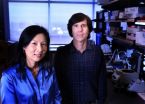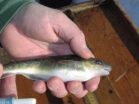(Press-News.org) Scientists have identified the gene that allows the Rubella virus to block cell death and reverse engineered a mutant gene that slows the virus's spread. Tom Hobman and a team of researchers at the University of Alberta's Faculty of Medicine and Dentistry believed that RNA viruses were able to spread by blocking the pathways in cells that lead to cell suicide, and isolated the responsible gene in Rubella, also known as German measles. They then created a mutant version of this gene that made the virus spread more slowly. These results are reported in PLoS Pathogens.
The Rubella virus is responsible for more birth defects worldwide than any other infectious agent. More generally, RNA viruses also cause many viral diseases in humans, including AIDS, influenza, hepatitis C, West Nile disease and Dengue fever. If these findings are applicable to other viruses, it would give researchers more tools for preventing the rapid spread of disease.
Hobman and his colleagues discovered that a well-known protein in the Rubella virus blocked the process that triggers cell death – allowing the virus to replicate and spread. The team then decided to conduct some reverse genetic experiments and mutated the capsid protein, which impaired the ability of the virus to replicate itself because cells would undergo cell suicide much earlier in the infection process and more often.
Hobman's team is now studying the West Nile and Dengue viruses to see if these RNA viruses prevent cell suicide in the same way. He hopes the discovery will one day lead to viral infections being limited and shutdown at an earlier stage.
### END
Reverse genetics allow scientists to slow the spread of the Rubella virus
2011-02-18
ELSE PRESS RELEASES FROM THIS DATE:
Engineering atomic interfaces for new electronics
2011-02-18
MADISON — Most people cross borders such as doorways or state lines without thinking much about it. Yet not all borders are places of limbo intended only for crossing. Some borders, like those between two materials that are brought together, are dynamic places where special things can happen.
For an electron moving from one material toward the other, this space is where it can join other electrons, which together can create current, magnetism or even light.
A multi-institutional team has made fundamental discoveries at the border regions, called interfaces, between ...
Identification of glaucoma gene brightens view for future therapies
2011-02-18
Glaucoma – a leading cause of vision loss and blindness worldwide – runs in families. A team of investigators from Vanderbilt University and the University of Florida has identified a new candidate gene for the most common form of the eye disorder, primary open angle glaucoma (POAG).
The findings, reported Feb. 17 in the open-access journal PLoS Genetics, offer novel insights into glaucoma pathology and could lead to targeted treatment strategies.
Elevated pressure inside the eye is a strong risk factor for POAG. Pressure increases because of increased resistance to the ...
Checklist cuts lethal ventilator-associated lung infections
2011-02-18
Cases of ventilator-associated pneumonia — the most lethal and among the most common of all hospital-associated infections — dropped by more than 70 percent in Michigan hospitals where medical staff used a simple checklist designed by Johns Hopkins researchers. Such pneumonias kill an estimated 36,000 Americans each year.
The findings, published online in the journal Infection Control and Hospital Epidemiology, show how a relatively simple series of steps, coupled with an education program and a culture that promotes patient safety, can save tens of thousands of lives ...
New Pitt projects will test brain computer interfaces for people with spinal cord injury
2011-02-18
PITTSBURGH, Feb. 17 – Researchers at the University of Pittsburgh have been awarded funding for two projects that will place brain-computer interfaces (BCI) in patients with spinal cord injuries to test if it is possible for them to control external devices, such as a computer cursor or a prosthetic limb, with their thoughts.
The projects build upon ongoing research conducted in epilepsy patients who had the interfaces temporarily placed on their brains and were able to move cursors and play computer games, as well as in monkeys that through interfaces guided a robotic ...
A genetic mutation allows Hudson River fish to adapt to PCBs
2011-02-18
NEW YORK, Feb. 17, 2011 – A research group led by a New York University School of Medicine scientist discovered a genetic variant that allows a fish in the Hudson River to live in waters heavily polluted by PCBs. In a study published in the February 18, 2011, online issue of Science, they report that a population of Hudson River fish apparently evolved rapidly in response to the toxic chemicals, which were first introduced in 1929, and were banned fifty years later. PCBs, or polychlorinated biphenyls, were used in hundreds of industrial and commercial applications, especially ...
Turning forests into fuel: New report outlines promise and limits of biomass energy in the Northeast
2011-02-18
(Millbrook, N.Y. – Feb 17, 2011) Forest biomass could replace as much as one quarter of the liquid fossil fuel now being used for industrial and commercial heating in the Northeastern United States. That's according to a new report released today by the Cary Institute of Ecosystem Studies.
But the report also has sharp caveats: The potential for forest biomass varies widely within the region, and forest resources must be carefully managed to protect the other important services and goods they provide. Under the right circumstances, however, the report found that forest ...
Unraveling how prion proteins move alon axons in the brain
2011-02-18
Researchers at the University of California, San Diego School of Medicine have identified the motors that move non-infectious prion proteins (PrPC) – found within many mammalian cells – up and down long, neuronal transport pathways. Identifying normal movement mechanisms of PrPC may help researchers understand the spread of infectious prions within and between neurons to reach the brain, and aid in development of therapies to halt the transport.
Their study is published in the February 18 edition of the journal Cell.
The small prion protein is found in the cell membrane ...
Pollution triggers genetic resistance mechanism in a coastal fish
2011-02-18
For 30 years, two General Electric facilities released about 1.3 million pounds of polychlorinated biphenyls (PCBs) into New York's Hudson River, devastating and contaminating fish populations. Some 50 years later, one type of fish—the Atlantic tomcod—has not only survived but appears to be thriving in the hostile Hudson environment.
Researchers from Woods Hole Oceanographic Institution (WHOI) have joined colleagues from New York University (NYU) and NOAA to investigate this phenomenon and report that the tomcod living in the Hudson River have undergone a rapid evolutionary ...
Study links social security improvements to longer life span
2011-02-18
New findings from researchers at New York Medical College suggest that when Social Security benefits are improved, people over the age of 65 benefit most, and may even live longer.
According to a new study published in the Journal of Public Health Policy, Americans over the age of 65 experienced steep declines in the rate of mortality in the periods that followed the founding of and subsequent improvements to Social Security. The authors urge that as Congress and the President discuss changes to Social Security they consider the benefit of reduced mortality and improved ...
World's first chemical guided missile could be the answer to wiping out cancer
2011-02-18
Deakin University medical scientists have created the world's first cancer stem cell-targeting chemical missile, placing them a step closer to creating a medical 'smart bomb' that would seek out and eradicate the root of cancer cells.
The Deakin researchers have worked with scientists in India and Australia to create the world's first RNA aptamer, a chemical antibody that acts like a guided missile to seek out and bind only to cancer stem cells. The aptamer has the potential to deliver drugs directly to the stem cells (the root of cancer cells) and also to be used to ...


